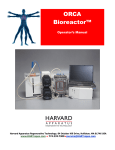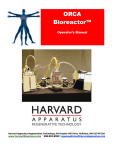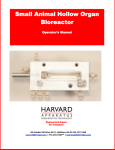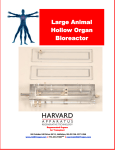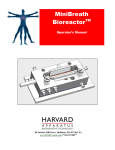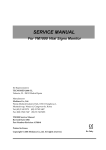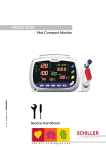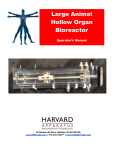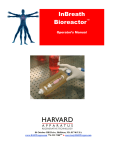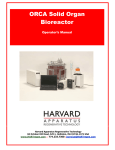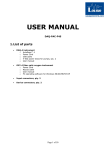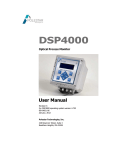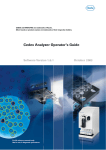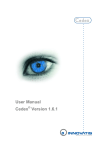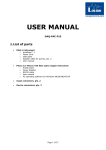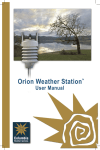Download ORCA Bioreactor Manual - Harvard Apparatus Regenerative
Transcript
ORCA Bioreactor™ Operator’s Manual Harvard Apparatus Regenerative Technology, 84 October Hill Drive, Holliston, MA 01746 USA www.harvardapparatusregen.com 508.893.8999[email protected] 1 June 19, 2013 Revision 1.2 Contents Contents 2 Disclaimer 3 Symbols 4 Overview 5 Chapter 1—Introduction 1.1 Warning & Caution Statements 6 1.2 Intended Use Chapter 2—Getting Started 2.1 Safety & Facility Requirements 2.2 General Equipment Components 6 7 8 Chapter 3— Assembly Instructions 3.1 Identifying Components 3.2 Assembling Components 12 14 i. Key for Flow Path Setup 20 ii. PharMed Tubing Size Reference 22 3.3 Chamber-Specific Flow Path Setup 23 i. Large Animal Organ System 14‖ Chamber 23 ii. Large Animal Organ System 10‖ Chamber 24 iii. Small Animal Organ System 5.5‖ Chamber 29 Chapter 4—Operating Instructions 4.1 Sterilization 32 4.2 Reservoir Bottle Configurations 33 4.3 Software 36 4.4 Heater Temperature Control & Pressure Channel Calibration 49 4.5 Image Capture System 52 Chapter 5—Care & Maintenance Ordering Information/ Replacement Part Numbers 2 53 54 Appendix A: Polestar Instructions 55 Appendix B: Frequently Asked Questions 74 June 19, 2013 Revision 1.2 Disclaimer: Use of the ORCA Bioreactor™ should be conducted by a trained and manufacturer qualified representative. Harvard Apparatus Regenerative Technology does not warrant unauthorized use of this product; Harvard Apparatus does not warrant that the operation of this product will be uninterrupted or error-free and makes no claim of warranty or condition. Harvard Apparatus reserves the right to change the instructions for use and any related products at any time without any prior notice and is not liable for any damages arising out of any change and/or alteration of the contents or product. This product is for RESEARCH USE ONLY. Copyright © 2013, Harvard Apparatus. All rights reserved. ORCA Bioreactor™ is a trademark of Harvard Apparatus. Harvard Apparatus, a division of Harvard Bioscience, owns the intellectual property rights to the ORCA Bioreactor. This material may not be reproduced, displayed, modified, or distributed without the expressed prior written permission of the copyright holder. U.S., international, and foreign patent applications are pending. 3 June 19, 2013 Revision 1.2 Symbols Used Symbol Definition Date of Manufacture Serial Number Catalogue Number Warning: This action will have a direct impact on the patient Caution: This action will have an impact on the product or operator Manufacturer This device complies with Directive 2006/95/EC relating to electrical equipment designed for use within certain voltage limits; this device also complies with Directive 2004/108/EC relating to electromagnetic compatibility. 4 June 19, 2013 Revision 1.2 Overview Harvard Apparatus Regenerative Technology partners with leading global scientists to provide specialized solutions. The company is uniquely positioned to develop advanced instrumentation to accelerate regenerative medicine, tissue engineering and cell therapy experimentation. From the beginning, in 1901, Harvard Bioscience companies worked closely with leading global researchers to produce products with the highest levels of performance, quality and support necessary for the new challenges of your life science research. We look forward to working with you to develop new tools to assist you in solving the new challenges of regenerative medicine from the lab bench to the patient. There are thousands of publications, in regenerative medicine to stem cell research, utilizing Harvard Apparatus products, but we are now introducing some newly developed products: one for regenerative organ generation and one for small volume cell delivery into organs. These products will serve researchers and physicians to accelerate both research and utilization of that research in patients. Harvard Apparatus Regenerative Technology provides: 5 Physiological bio-sensors and transducers to measure biological variables to better understand animal to cell physiology: mechanically, chemically, electronically Physiological data acquisition systems with advanced electronics, physiological data manipulation algorithms to measure, monitor, control and understand complex physiological events Physiological macro to nano fluidics infusion pumps Animal to cell electrophysiological monitoring systems Organ to cell perfusion bath and chambers to mimic physiological conditions to study drug, nutrient, gene and cell therapies Live cell imaging and perfusion chambers to better understand the affect of shear force, drugs, nutrition on cells and tissues Cell engineering tools from electroporation to pneumatic injectors June 19, 2013 Revision 1.2 Chapter 1: Introduction The ORCA Bioreactor is the first system designed to meet the needs of the modern regenerative medicine research scientist. The system is able to address the needs of both the decellularization and recellularization processes of various organs. Physiological conditions can be mimicked through control algorithms that regulate flow rates, profiles, and pressures. Critical readings can be taken from both inside the organ as well as in the support environment through the use of sensors. The Concurrent Method Development software logs all modifications and operator entries along with the result that was measured with the system sensors, allowing a complete review of an experiment and direct translation into a research method. A method storage system makes it easy to reproduce methods and conditions across multiple experiments. The image capture software allows for images to be captured in real time from cameras monitoring visible, IR, UV, and fluorescence; other systems such as ultrasound / ECHO are supported. 1.1 Warning and Caution Statements The use of a WARNING statement in this User Manual alerts you to a potential safety hazard. Failure to observe a warning may result in a serious injury to the user. The use of a CAUTION statement in this User Manual alerts you to where special care is necessary for the safe and effective use of the product. Failure to observe a caution may result in minor injury to the user or damage to the product or other property. 1.2 Intended Use The ORCA Bioreactor is a system used for the purposes of monitoring and studying an isolated organ; it is intended for research use only. WARNING: Use of this device in non-research settings must be conducted under local Regulatory requirements; consult your local Regulatory Authority. 6 June 19, 2013 Revision 1.2 Chapter 2: Getting Started The following conditions must be met prior to using the In-Breath Bioreactor: 2.1 General Safety Requirements WARNING: The ORCA Bioreactor should only be used by qualified personnel who have been trained by the manufacturer or other Authorized Representative. Unauthorized use of this device is not recommended. WARNING: To prevent contamination, aseptic procedures must be followed and personal protective equipment must be worn at all times when handling and using the Bioreactor. WARNING: Wherever blood products are used, Universal Precautions must be followed. Facility Requirements Assure that the facility is able to provide a clean, safe, and suitable area for aseptic cell processing. It is recommend that all manipulations of the unit once sterile are performed in a biological safety cabinet (laminar flow hood). WARNING: Failure to provide a means to conduct aseptic cell processing may result in harmful contamination. 7 June 19, 2013 Revision 1.2 2.2 Equipment Components 1) Store the ORCA Bioreactor in a cool, dry place, free from dust and other potential contaminants until ready to use. 2) Assure that the ORCA Bioreactor package was received completely and without damage; if the package arrived as damaged contact your local technical support group. 3) Ensure that all parts of the ORCA Bioreactor package and its peripheral devices are in good condition. Do not use damaged parts. Overview of Main ORCA Bioreactor Components D B A B C C (A) Heater Reservoir & Temperature Control System (B) Peristaltic Pumps (C) Organ Chamber (D) Pulsatile Pump 8 June 19, 2013 Revision 1.2 Heater Reservoir The heater is used to maintain temperature throughout the system to emulate physiological conditions. The reservoirs hold a volume of 0.25L to 4L of media. The reservoir has built-in ports for interaction with the oxygenator and the organ chamber, as well as a port for a temperature monitoring probe. There are different sizes of bottles (large and small flow) that have different size ports to accommodate a wide variety of tubing and flows. Pumps Pumps are selected according to the organ and protocol requirements. The ORCA controller along with your pumps of choice address the needs of the decellularization and recellularization processes of various organs. Several types of pumps may be controlled, including peristaltic, pulsatile and syringe. A maximum of four pumps are used simultaneously on a system. The ORCA controller may be configured to control either four peristaltic pumps or three peristaltic pump heads and a pulsatile blood pump. Both configurations typically include two single channel dual head peristaltic pumps. A 4th pump may be added to the four unit controller to serve as a spare unit. Pump head configurations may be altered at any time to meet the most demanding protocols. Selection of the pulsatile pump normally occurs when pulsatile flow rates in excess of 2L/min are required. This selection must be made at the time of purchase. If the ―four peristaltic pump controller‖ is chosen, the fourth pump may be added at any time. A fourth peristaltic pump adds flexibility to accommodate elaborate protocols but is not required and can be added at a later time. These configurations can be used to accommodate protocols that require a perfusion pump, ventilation pump and a pump that will provide flow to the oxygenation system and a gas monitoring system. Exterior medium feed and waste bags can also be accessed using channels on the double head double channel pump. 9 June 19, 2013 Revision 1.2 Pumps—Peristaltic Peristaltic pump heads are available in single and dual channel versions. One Single-channel Head {881001} Two Singlechannel Heads {881003} Four Single-channel Heads {881010} Up to four (4) heads may be used on each peristaltic pump to provide flexibility in flow range as well as the number of channels required for the most challenging protocols. High Capacity: Up to 1200mL/min/head Mid Capacity: Up to 500mL/min/head One Dual-channel Head {881002} Two Dual-channel Heads {881004} One each Single- and Dual-Channel Heads {881005} Additional Part Numbers: {881011} Mounting Screw for Two pump heads {881012} Mounting Screw for Three pump heads {881013} Mounting Screw for Four pump heads Pumps—Pulsatile The pulsatile pump is used in some large animal systems to emulate ventricular action of the heart. It allows for minimal hemolysis and is ideal for moving emulsions, suspensions, and blood. 10 June 19, 2013 Revision 1.2 Chambers Solid Organ Chambers Large Solid Organ Chamber 14‖ {880420} Intermediate Solid Organ Chamber 10‖ {880429} Small Solid Organ Chamber 5.5‖ {880431} (holds approx. 32.8L) (holds approx. 11.6L) (holds approx. 2L) Solid organ chambers are autoclavcable and are suitable for multiple species and sizes of organs. Tubing sets can be changed to accommodate the wide range of flow rates. The layout of the chamber and use of clear materials allows for easy visibility of the organ being studied. Chamber orientation can be adjusted depending on the decellularization and cellularization procedures. Chamber access ports are built in for removal and addition of media. Numerous sampling ports are included, and the built-in windows allow for manual access to an organ. Hollow Organ Chambers {880403} The rotating double chamber is specifically designed for cell seeding and culturing both surfaces of a tubular matrix. The intraluminal and extraluminal flow paths may be connected or maintained separately. The hollow organ chambers allow seeding and culturing of different cells types on either side of the tubular structure, providing homogeneity. The design allows for enhanced oxygenation and mass transport between the medium and cells. Large and small animal versions are available. 11 June 19, 2013 Revision 1.2 Chapter 3: Assembly Instructions 3.1 Identifying Components This is a typical system. Actual components will vary according to the system ordered. Please check your order and shipping manifest for an exact list of components. Pumps Pump Cables {5155720} Pump Drive {881000} with appropriate heads. The type and number of heads will vary with each system. Pressure Transducers 4 channel controller cable {880366} Laptop Transducers {880360} are shipped in sealed sterile packaging Pressure Calibrator {734479} Laptop and power cables will vary depending on the order 12 June 19, 2013 Revision 1.2 Controller Communication cable Power Cable {511301 US; 5113010 Euro} (see parts list for other countries) ORCA Controller {880404} Temperature Probe {551492—527560} Heater & Reservoir Heater {880405} 110V {880399} 220V Liner {880440} Reservoir Types 880406 (4L) -880421 (500mL) 880436 (1L)–880437 (2L) 13 June 19, 2013 Revision 1.2 3.2 Assembling Components 1. Place power cord into controller and electric source. 2. Connect laptop power cord to the laptop and electric source. 3. Connect communication cord to Laptop and ORCA Controller. Cable color may vary. 4. Connect pump communication cord to the back of the pump and the ORCA Controller. It may be easier to identify the pumps if a label is attached to the drive motor identifying the ORCA pump port. 14 June 19, 2013 Revision 1.2 5. Identify any extra pump heads and mounting screws that have been ordered. These may not be immediately needed for the system but should be kept in a safe place. Pump heads (either single or dual channel) Pump head mounting screws (mounting hardware for either 2,3 or 4 pump heads). 6. Connect heater power cord to the ORCA controller. Add liner to heater and wrap it over the top of the heater. 7. Attach the temperature probe to the appropriate connector 1-4. Up to 3 can be used with an ORCA 3+1 controller (system with a pulsatile blood pump). 15 June 19, 2013 Revision 1.2 8. Mark the cables on the connector with the number of the channel that they represent. This will make for easier identification later. Connect the pressure transducer cable to the ORCA controller. 9. When the system is to be used the connectors (labeled 1-4) will be connected to the pressure transducers (see Operations section for calibration procedure). Note: Make sure to clean transducers thoroughly before use. Pressure transducers are NOT autoclavable. Some media types have proteins and other materials that can nonspecifically bind to the pressure sensor and adversely affect the pressure readings. One technique used to minimize this effect is to inject 3 mL of sterile water through the swabble port. This provides an insulating fluid between the transducer and the medium without a negative effect on the pressure readings. Note: While not required, it is a good idea to line up the Harvard Apparatus logo sticker with the front of the chamber before screwing on the chamber lid. 16 June 19, 2013 Revision 1.2 10. Place ball on bubble trap base, then place bubble trap head on base. The actual location of the bubble trap(s) may vary according to the system being used. The location of the bubble trap (and number required) as well as the right angle fittings may vary depending on the protocol being implemented. Note: In order to install the right angle fittings the bottom fitting must first be disassembled in order to fit through the Lid hole. Swabble ports {880434} Bubble Trap Head {14‖ chamber #30295} {10‖ chamber #30442} Bubble Trap Ball {14‖ chamber 1‖ ball #30609} {10‖ chamber 3/4‖ ball #30564} 17 June 19, 2013 Revision 1.2 11. There are two fittings on the bottom of the chamber that allow filling and draining of the chamber. Add Quick Disconnects to facilitate the connections using an appropriate size of tubing from the chamber fitting. 12. The level of liquid in the chamber can be determined by cutting the rigid tubing inside the chamber to the desired height. Note: A piece of tubing may be added to test the unit without an organ in place. 18 June 19, 2013 Revision 1.2 13. Add Temperature probe to reservoir. 14. Add appropriate size and length of tubing to the reservoir inlets. Note: It is recommended that commonly used sizes of tubing are glued to a plastic clip board. Take a one inch piece and glue laterally and a ¼‖ piece glued so that the internal ID of the tubing is easily displayed. This is useful because otherwise it is sometimes difficult to tell the correct size tubing needed at a glance, particularly when differentiating between PharMed #17 and #18. See next page for a reference guide. 15. Seal the 1/2 inch Barb Fittings that are not in use with caps. {30603} This is to maintain the system’s sterility. 19 June 19, 2013 Revision 1.2 Tubing Pathway Setup Key Pumps Flow Paths Head Config. Typical Function Perfusion pathway into organ Perfusion into organ for smooth high flow rate Two Single Channel Heads Combined by a Y Empty chamber to reservoir Oxygenation/Polestar pathway ―Sipper‖ tube Four Single Channel Highest flow rate Heads Combined by a Y Ventilator pathway Flow to Oxygenator Two Dual Channel Heads Flow to Pre O2 sensor (4 channel) Flow to O2,CO2,pH sensor 3rd Head Arrows indicate direction of flow TC May be added to the pump with two dual channel heads to allow addition and removal of reservoir medium. Thermocouple Tubing Sizing PharMed Opaque, flexible Tygon Clear, flexible Teflon Translucent, more rigid 1/8‖ L/S #16 (1.6mm ID) {720963} 1/8‖ ID {721259} 1/8‖ OD {30358} 3/16‖ L/S #25 (4.8mm ID) {720964} 1/4‖ L/S #17 (6.4mm ID) {720965} 1/4‖ ID {721256} 1/4‖ OD {30345} 3/8‖ L/S #18 (7.9mm ID) {720967} 3/8‖ ID {721270} 3/8‖ OD {30346} 1/2‖ (12.7mm ID) {720970} 1/2‖ ID {721268} 1/2‖ OD {30347} Key cont. next pg. —> 20 June 19, 2013 Revision 1.2 Connectors Clamps 1 1 /8‖ clamp 30497 /4‖ clamp 721670 1 /8‖ connector 30357 1 /4‖ connector 30370 3 3 /8‖ clamp 721671 1 /2‖ clamp 30495 /8‖ connector 721577 /2‖ connector 30496 Connector, 3/8 NPT - 3/8‖ Barb right angle 30511 Connector, 3/8NPT - 3/8‖ Barb 30526 1 Fittings Luer Lok Fitting 30259 Fitting, Right Angle 30420 Misc Bubble Trap 1/2‖ 30430 Right Angle Trap xxxxx 1 /2‖ plug 30410 /4‖ Barb—1/2‖ NPT 30401 /8‖ Barb—1/4‖-28 UNF 30407 Bubble Trap 1/4‖ 30450 /4‖ barb - 1/8‖ Right angle 30514 Valve, 1/x‖ Diastolic after load pressure 880427 Y Barbs 3 /16‖ Y barb 3 /8‖ Y barb 721587 1 30350 1 1 1 /4‖ barb - 1/4‖ NPT 30494 /8‖ pipe - 1/8 NPT Adapter 30325 Female Luer 1/4-28 30472 Valve, 1/2‖ Diastolic after load pressure 880426 Swabble Port 880434 Pulsatile Pump head xxxxx Reducing Connector, 3/8 barb –1/4‖ Barb 30371 1 21 June 19, 2013 Revision 1.2 PharMed Tubing Reference Guide The following is intended to be a quick reference guide for deciding what size of PharMed tubing is currently being used. As previously mentioned, it is recommended that tubes of the sizes that your lab commonly uses are glued to a plastic clip board, allowing for even simpler comparison. PharMed Tubing # Front View Tubing size #13 5/32” (4.0mm) OD 0.03” (0.8mm) ID #14 3/16” (4.8mm) OD 0.06” (1.6mm) ID #16 1/4” (6.4mm) OD 0.12” (3.1mm) ID #25 5/16” (7.9mm) OD 0.19” (4.8mm) ID #17 3/8” (9.5mm) OD 0.25” (6.4mm) ID #18 7/16” (11.1mm) OD 0.31” (7.9mm) ID #82* 3/4” (19.1mm) OD 0.5” (12.7mm) ID Lateral View * Used for connections—not for use in the peristaltic pump Note: When feeding the tubes through a peristaltic pump, it is recommended that you set a convention for flow direction that you follow for all pumps (i.e. forward flow is always designated as flow from left to right). This will help avoid potential confusion. 22 June 19, 2013 Revision 1.2 3.3 Chamber-Specific Flow Path Setup Large Animal Organ System 14‖ Chamber Note: The following is a diagram representing a configuration for the bioreactor for a large animal lung system. This diagram is not a replacement for your laboratory’s protocols; be sure to follow your individual experimental procedures. Your individual laboratory’s setup may differ from what is depicted below. G2 G3 A3 G2 Oxygenator A3 G1 Gas in Ventilator A2 Gas out A2 A1 D1 A2 D2 D3 J1 I1 A3 Pre Organ O2 A1 A1 A2 A3 D1 D2 D3 G1 G2 G3 G4 I1 N Y 23 PharMed L/S #16 PharMed L/S #16 PharMed L/S #16 PharMed L/S #17 PharMed L/S #17 PharMed L/S #17 PharMed L/S #18 PharMed L/S #18 PharMed L/S #18 PharMed L/S #18 Teflon 3/8”Clamp 3/8” Y Barb 1/8” 1/8” 1/8” ¼” ¼” ¼” 3/8” 3/8” 3/8” 3/8” 3/8” feet 2 2 4 2 1 2 2 1 2 13” 2 G4 G5 D4 I1 June 19, 2013 Revision 1.2 Large Animal Organ System 10‖ Chamber Aorta Pressure #2 Spare Plug Port Left Atrium Pressure #1 Right Atrium Pressure Chamber or Spare Pressure #4 Temperature Probe Chamber Vent Organ elevator handle Compression lock screw Left Ventricle / Pulmonary Artery Right Ventricle Arm Articulator holder Aorta Feed Additional Sensor Port {30470} Chamber Quick Connect Fill {30607} 24 Chamber Quick Connect Drain {30607} June 19, 2013 Revision 1.2 Large Animal Organ System 10‖ Chamber (cont) 25 June 19, 2013 Revision 1.2 Large Animal Organ System 10‖ Chamber (cont) Note: The following is a diagram representing a configuration for the bioreactor for a large animal lung system. This diagram is not a replacement for your laboratory’s protocols; be sure to follow your individual experimental procedures. Your individual laboratory’s setup may differ from what is depicted below. G2 Oxygenator A3 G1 G2 G3 A3 Gas in Ventilator A2 Gas out B2 A1 D3 D2 A2 J1 G4 A3 Pre Organ O2 A1 A1 A2 A3 D1 D2 D3 D4 F G1 G2 G3 G4 G5 I1 Y AR 26 PharMed L/S #16 PharMed L/S #16 PharMed L/S #16 PharMed L/S #17 PharMed L/S #17 PharMed L/S #17 PharMed L/S #17 Teflon PharMed L/S #18 PharMed L/S #18 PharMed L/S #18 PharMed L/S #18 PharMed L/S #18 Teflon Tubing 3/8” Y Barb Reducer 3/8 -1/4” 1/8” 1/8” 1/8” ¼” ¼” ¼” ¼” ¼” 3/8” 3/8” 3/8” 3/8” 3/8” 3/8” feet 2 2 4 2 2 5 3 2 3 1 3 2 3 9” I1 D4 G5 June 19, 2013 Revision 1.2 Large Animal Organ System 10‖ Heart Chamber Left ventricle Aorta Pulmonary artery Right Ventricle In from aorta Out to Reservoir Out to peristaltic pump 27 June 19, 2013 Revision 1.2 1/2‖ Diastolic after load pressure valve Tighten (clockwise) to increase pressure 28 June 19, 2013 Revision 1.2 Small Animal Organ System 5.5‖ Chamber Note: The following is a diagram representing a configuration for the bioreactor for a small animal lung system. This diagram is not a replacement for your laboratory’s protocols; be sure to follow your individual experimental procedures. Your individual laboratory’s setup may differ from what is depicted below. U2 U3 B1 U2 Oxygenator A3 U1 Gas in A1 Gas out A2 Ventilator A2 A3 U4 U6 U5 A1 I1 A3 Pre Organ O2 A1 D1 A1 A2 A3 D1 D2 D3 D4 N Y U1 U2 U3 U4 U5 X 29 PharMed L/S #16 PharMed L/S #16 PharMed L/S #16 PharMed L/S #17 PharMed L/S #17 PharMed L/S #17 PharMed L/S #17 3/8”Clamp 3/8” Y Barb PharMed L/S #25 PharMed L/S #25 PharMed L/S #25 PharMed L/S #25 PharMed L/S #25 Y Barb 1 / 8‖ / 8‖ 1 / 8‖ ¼‖ ¼‖ ¼‖ ¼‖ 1 3 /16‖ /16‖ 3 /16‖ 3 /16‖ 3 /16‖ ¼‖ 3 ft 2 2 4 2 1 2 2 D3 D2 D4 2 1 2 2 1 June 19, 2013 Revision 1.2 5.5‖ Chamber Lid top 30 June 19, 2013 Revision 1.2 5.5‖ Chamber Lid (continued) 31 June 19, 2013 Revision 1.2 Chapter 4: Operating Instructions Prior to Starting Assure that all the requirements identified in Chapter 2 have been successfully met. Personnel using the ORCA Bioreactor should read through this manual in its entirety prior to using the device. WARNING: Failure to follow aseptic techniques and failure to train on all processes and procedures prior to using the bioreactor may result in critical delays, contamination, and other harmful events. 4.1 Sterilization Sterilization can be performed using EtO or by autoclaving. It is strongly recommended that all fittings be loosened prior to sterilization procedure. Tubing has a tendency to form around the barb during an autoclave cycle and can become loose and allow leaks. One possible sterilization procedure would involve assembling the tubing set as it is to be used in the bioreactor and placing it into a sterilization bag to be autoclaved; the chamber could then be sterilized in a separate sterilization bag. Be sure to follow your laboratory’s individual sterilization protocols. It is also strongly recommended that PharMed tubing be used throughout the system. It has shown to be the most resilient to the intense heat and pressure of the autoclave. Tygon tubing is very susceptible to warping after autoclavation. If the flow path is autoclaved and has Tygon tubing, check all barb connections. In many cases Tygon tubing will become soft and may slide off the barb after autoclaving when pressure is applied. If the tubing is soft on the barb, it is recommended that the portion of the tubing that was on the barb is cut and discarded and that fresh tubing is slid onto the barb. Ty-wraps may also be used on barb fittings. 4.2 Reservoir Bottle Fittings & Typical Usages Note: The reservoir bottle for the ORCA Bioreactor comes in a variety of configurations. The various models are all displayed in the next few pages of this manual. Please find the model that was included in your laboratory’s particular bioreactor package. 32 June 19, 2013 Revision 1.2 Large Animal Note: This diagram depicts a typical usage for each of the reservoir bottle ports in a large animal system. Be sure to follow your laboratory’s individual protocols. 2 1 3 1) 3/4‖ tube; Pulsatile for trachea 2) 1/8‖ tube; Polestar transducer 4 11 5 10 6 9 8 3) 3/8‖ rigid tube; PA on lung or pressure control for valve peristaltic 4) 3/8‖ tube; PA on lung or pressure control for valve peristaltic 5) 1/8‖ rigid tube; Polestar transducer 6) 1/4‖ rigid tube; chamber circulation 7) 1/4‖ tube; chamber circulation 8) 1/4‖ rigid tube; oxygenator circulation 9) 1/4‖ tube; oxygenator circulation 7 10) 1/8‖; thermocouple 11) 1/2‖ tube; Pulsatile for trachea Small Animal Note: This diagram depicts typical sizing & usage for each of the reservoir bottle ports in a small animal system. Be sure to follow your laboratory’s individual protocols. 1 2 3 2) 1/8‖ rigid tube; Polestar transducer 4 11 10 5 6 9 8 33 1) 1/8‖ tube 7 3) 1/4‖ rigid tube; PA on lung or pressure control for valve peristaltic 4) 1/4‖ rigid tube; PA on lung or pressure control for valve peristaltic 5) 1/8‖ tube; Polestar transducer 6) 1/4‖ rigid tube; chamber circulation 7) 1/4‖ rigid tube; chamber circulation 8) 1/4‖ rigid tube; oxygenator circulation 9) 1/4‖ rigid tube; oxygenator circulation 10) 1/8‖; thermocouple 11) 1/8‖ rigid tube June 19, 2013 Revision 1.2 Cap mounting Plastic Bottle Large Animal Modified 1/2‖ Barb—3/8‖NPT Modified 1/8‖ tube—1/8‖NPT Modified 1/4‖ Barb —1/4‖NPT Luer Lok - 1/4‖ 28—1/8‖ barb Caps are available to seal the 1/2 inch Barb Fittings 1/4—28 nut 1/8‖ NPT 1/2‖ Barb —1/4‖NPT 3/8‖ NPT Nuts 3/8‖ Barb —1/8‖NPT 1/4‖ NPT Nuts 1/4‖ Barb —1/8‖NPT 1/4‖ NPT Nut 34 June 19, 2013 Revision 1.2 Manifold allowing multiple feeds or return lines may be created as necessary. Add the number of Slip Luer T-fittings as required. Polycarbonate products are autoclavable. They must be thoroughly rinsed before autoclaving because detergent residues cause crazing and spotting. Autoclaving cycles should be limited to 20 minutes at 121°C. PC shows some loss of mechanical strength after repeated autoclaving and therefore may not function well under high-stress applications, such as centrifugation. Inlet/Outlet Adaptor T Fitting 722749 Cap 721449 Clear Nut 722734 Note: By convention, green caps will indicate inlets to the reservoir, while the red caps will indicate outlets Green Nut (on inlet )722732 35 Red Nut (on outlet ) 722731 June 19, 2013 Revision 1.2 ORCA Controller Software Operation Instructions The operation software allows for control of flow rate and gives temperature, pressure, and flow rate readouts over time. The user can control a maximum of four pumps at once; both pulsatile and peristaltic pumps can be utilized. IMPORTANT Note: Before use of the software, be sure to turn off Windows auto-updates, which could cause the computer to restart whilst running an experiment. Before running the software for the first time, locate the folder ―Harvard Data‖ on the desktop and copy/paste it into the My Documents folder as a backup. This ensures that a backup copy is available in case the program is ever shut down incorrectly. Click on the Harvard Data Folder on the desktop. Select ―COPY‖. Click on the My Documents Folder on the desktop. Select ―PASTE‖. Running & Terminating the Program To run the program, select the initiation icon from the Desktop. It is important to shut down the ORCA controller software in the following manner: Close the program using CTRL+Q or the ―Stop‖ option. WARNING: Shutting down the program by shutting off the PC or using any other method may result in a corrupted CONFIGURATION FILE and not allow the program to initiate properly the next time it is used. As a result, the red X button normally found in the upper right corner of the screen has been disabled. 36 June 19, 2013 Revision 1.2 The Main Screen Master Controls: Starts all pumps. In the above state, no data logging is occurring. Clicking the green button will begin the program. Stops all pumps. Incrementally adjusts flow rate of all pumps When the trials are running, the master controls will appear as above. Use the red button to stop all data logging. 37 Adds an Experiment note. June 19, 2013 Revision 1.2 Starting Pump Programs The green icon starts the programs of all active pumps and begins data logging. Before data logging begins, the user is prompted to either create a new file or append. If the ―create‖ option is chosen but the file name has already be taken, the program will issue a warning. The disk icon indicates that you are collecting data. Experiment Log All data will be continuously entered into the experiment log until the user stops the run. Experiment Notes Clicking on the Notepad icon allows the user to enter an experiment note. 38 June 19, 2013 Revision 1.2 Enable/Disable Pump This primes a pump for use or deactivates a pump when not in use. Start/Stop Run Starts or stops the corresponding pump. Flow Rate Control These up/down arrows manually adjust the flow rate while the run takes place. The flow rate can also be altered by clicking on ―x.xx ml/min‖ just below the pump icon and entering a value. Flow Direction Changes the direction that the pump rotates; a right arrow indicates clockwise. Create Step Use this to create a Step. See ―Step Creation‖ for additional info. Select Step Use this to select a Step. See ―Step Creation‖ for additional info. Green Light Glows when pump is on. Step Mode See ―Step Mode‖ for additional info. Start Mode See ―Start Mode‖ for additional info. Stop Mode See ―Stop Mode‖ for additional info. Repeat Mode See ―Repeat Mode‖ for additional info. Pump Selector Choose from peristaltic, syringe, pulsed blood, or ventilator modes. 39 June 19, 2013 Revision 1.2 Step Creation/Modification In these windows, you are able to create a new step or update an existing one. The program asks for the user to input a step name and description for each new step or updated step. You can see the step in graphical form using the Step Viewer/Selector. When the step parameters have been selected, a new yellow gear with a green cross will pop up. You must press on this gear and save the step for it to be implemented. Otherwise any changes made will be discarded upon leaving the window. 40 June 19, 2013 Revision 1.2 Pump Calibration To access the pump calibration menu, click on the image of the pump that you wish to calibrate. From this menu, the head configuration and the correct tubing size can be selected. The calibration factor can also be adjusted. Head Configuration: Select from single, double, triple, or quadruple head configurations. Note: The max speed of the motor is 300rpm. Tubing Size: Select the PharMed tubing size that you wish to use. See table below for a description of the available tubing sizes and their corresponding flow constraints. When you have selected a particular tubing size, the minimum and maximum flow rates for the selected tubing will automatically be displayed below. CAUTION: The user must know the tubing size being utilized for each pump head and verify that the correct tubing size is selected. The pump cannot verify this for the user. Calibration Factor: The number set for this parameter is the inverse of the variance of the liquid delivered. The calibration factor is selected based on the deviation from optimal flow rate. The user may wish to run their perfusate at a specified rate into a graduated cylinder in order to test the actual volume delivered. If the volume delivered is less than the expected amount, the calibration factor can be set at a value greater than one to compensate for this deviation. Specifications for Pharmed tubing Tubing Size #13 #14 #16 #25 #17 #18 #82* ml / min 0.018 - 18 0.63 - 63 0.24 - 240 .51 - 510 0.8 –840 1.1 - 1,140 .02—13L ID in. (mm) .03‖ (0.8) .06‖ (1.6) .12‖ (3.1) .19‖ (4.8) .25‖ (6.4) .31‖ (7.9) .5 (12.7) 1 1 /16‖ (1.6) 1 3 1 3 /16‖ (.188) 1 Barb Size 5 OD in. /16‖ (1.6) /32‖ (.156) 3 /8‖ (3.2) /4‖ (.25) 5 /16‖ (4.8) /16‖ (.313) 3 /4‖ (6.4) /8‖ (.375) 7 /8‖ (9.5) /16‖ (.4375) 1 /2‖ (12.7) 3 /4‖ Max Pressure-continuous psig (bar) 25 (1.7) 25 (1.7) 25 (1.7) 20 (1.4) 15 (1.0) 10 (0.7) 10 (0.7) Max Pressure-periodic psig (bar) 40 (2.7) 40 (2.7) 40 (2.7) 35 (2.4) 20 (1.4) 15 (1.0) 15 (1.0) Use in Dual Channel Head YES YES YES YES YES NO NO Part Number (25 foot roll) (7.6m) 720958 720960 720963 720964 720965 720967 720970 * Used for connections—not for use in the peristaltic pump 41 June 19, 2013 Revision 1.2 Operation Mode On this screen, Run Mode, Flow Rate, and Flow Direction can be controlled. Run Mode There are four options to choose from. Constant Rate: provides a constant perfusion rate Constant Pressure: pump #1 alters its flow to maintain constant pressure Pressure Oscillation: adjusts the flow to bounce between two set pressure points Pulsatile Cycle: provides a pulsatile flow In Constant Rate mode, flow is set by the user and maintained at a constant rate. Flow direction may be changed. In Constant Pressure mode, constant pressure is set by the user and the pump varies the flow to maintain the pressure setting. Max rate is the maximum rate the pump is allowed. Min rate is the minimum rate the pump is allowed. PID Setting P Gain is the proportional gain which dictates how fast the pump is allowed to change to obtain the required setting. PID Setting I Gain is the integral value used to adjust the baseline and fine tune the rate at which the pump is allowed to move to reach the programmed setting. Users can also choose between Standard Mode and the Average setting. Standard Mode uses the raw data of each reading. The Average setting takes a rolling average of the last 40 readings. A reading is typically about 20 milliseconds. This setting is often used to smooth out the baseline. 42 June 19, 2013 Revision 1.2 In Pressure Oscillation Mode, the system alternates between using the high rate to obtain the high pressure target and using the low rate to obtain the low pressure target. The pressure targets are in units of mmHg and the rates are in ml/min. In Pulsatile Cycle Mode, the program allows for a pulsatile flow to be provided by the peristaltic pumps. There are five modes of operation: -Standard -Set Rate mode -Set pressure mode -Inverse mode -Reverse mode In Standard Mode, the parameter BPM allows the beats per minute to be set. Systole % allows the % of the cycle that is delivering to be set. This value is typically about 35% which must be entered as ―0.35‖. 43 June 19, 2013 Revision 1.2 In Set RATE Mode, Systole % is the same as in Standard Mode. Systole rate is the rate (in ml/min) that the pump is allowed to increase to reach the set delivery rate. Distole rate is the rate (in ml/min) that the pump is allowed to increase to reach the set fill rate. In Set Pressure Mode, constant pressure is set and the pump varies the flow to maintain the pressure setting. Max rate is the maximum rate the pump is allowed. Min rate is the minimum rate the pump is allowed. PID Setting P Gain is the proportional gain which dictates how fast the pump is allowed to change to obtain the required setting. PID Setting I Gain is the integral value used to adjust the baseline and fine tune the rate at which the pump is allowed to move to reach the programmed setting. In Inverse Mode, the setting for the diastole and systole cycles are reversed. Otherwise, the parameters are the same as in Standard Mode. 44 June 19, 2013 Revision 1.2 In Reverse Mode, the systole is operated on during the delivery phase. The diastole is operated on during the fill phase. Start Mode The user has the option to set a time delay before the pump starts running at the rate at which it has been set, or can opt for the ―start immediately‖ setting. Ramp allows the user to select the speed at which the pump will deliver. There are options in increments ranging from very slow to very fast. ―None‖ is also an option for type of ramping. Note that the maximum flow rate is a constraint set by the type of tubing used. 45 June 19, 2013 Revision 1.2 Repeat Mode Four modes of repeat are allowed: No repeat Repeat until Repeat # of times Repeat increase N In No Repeat mode, the step does not repeat. In Repeat Until (User Stop) Mode, the step will repeat until the user stops the program manually. The Flip Direction switch allows the flow to be reversed. In this mode, the step will be repeated for a fixed number of times. The Count option allows you to set the number of iterations you want (there is no limit). The Flip Direction switch up allows the flow to be reversed on every other cycle. Ie 10 repeats with flip direction switch up would result in 1/2 (5) the cycles in the forward direction and 1/2 (5) in the reverse direction. Switch down and all cycles in the same direction. In Repeat/Increase Mode, the speed of the pump increases with every subsequent iteration. Count allows you to set the number of iterations. Change by allows you to set how much to increase the speed of the pump for each time the step is repeated Max value is the maximum flow in ml/min (this is limited by the tubing) Keep Pump Running allows the pump to continue to run as 46 the final flow rate is reached June 19, 2013 Revision 1.2 Notifications This window allows the user to enter contact information in order to be notified by email when certain events occur. At present, text messaging is not active so entering the phone number has no effect. This screen allows you to select specific events for which you will receive notification. Saving Files Be certain to create an experiment folder in my documents by naming the experiment (see below ―Experiment_Name‖. Once you save after naming the experiment a folder will be available in the computers My Documents Folder and can be copied onto a portable drive and taken to another PC for evaluation. 47 June 19, 2013 Revision 1.2 Reading Data Files In order to read data logged as an Excel file, the computer that you are using to view the files must have a converter program installed. One such program is TMS Importer which can be obtained from http://zone.ni.com/devzone/cda/epd/p/ id/2944 or http://vimeo.com/22639555 Analog Inputs The ORCA controller allows you to feed in any analog signal and this software can capture, display, and save the traces. This is commonly used with the PoleStar gas monitoring system. 48 June 19, 2013 Revision 1.2 Heater Temperature Control & Pressure Channel Calibration Heater Temperature Control Access the Temperature Control menu through Tools—>Heater. Probe to Control allows the user to select between four different probes, labeled TC-1 to TC-4. Heater Control can be set to either Enabled or Disabled. SetPoint allows the user to set the temperature in degrees Celsius. The Pressure Channel Calibration menu can be accessed through Tools—>Calibration—>Pressure. Pressure Channel Calibration First, select the desired pressure channel. You can have up to four channels. The Filter may be set to either Mean or Raw. The Actual Value is the instantaneous value for the pressure reading. Average Value is the average reading over a few seconds. The Average Cycle serves as an ―update light‖ to let the user know when the average has been updated. Use the Zero button to zero the actual value reading, and Cal Value along with the Calibration button to calibrate pressure readings. The zero is normally set by opening the transducer to air. Wait until you have a stable reading (one that stays constant for the duration of two flashes of the green light). WARNING: You must have a pressure measurement device and a way to increase the pressure. IF you press the calibration button and do not have a way to measure the actual pressure you will establish a false reading and not be able to use it (typically 100 mmHg). 49 Manual Pressure Calibrator {73-4479} June 19, 2013 Revision 1.2 Chart Readouts Note: In any tab, you may click on the top and bottom numerical values on the y-axis at any time to change the max and min values. Click on the actual high number, it will light up, manually type in the high level you want. Repeat this for the low value of the Y axis. This is done as if you are changing a text value. Also be sure to check the boxes next to the channels that you would like to have plotted. The first tab is for monitoring the temperatures over time of the channels (up to four) that you have in use. This is an example pressure readout for the various pumps’ flow paths. The pressures corresponding to pumps 1, 2, and 4 are being displayed. Note: If you do not see all of the traces that you are expecting, one or more of the traces could be overlaid. In order to remedy this, turn off traces sequentially by unchecking the corresponding boxes next to ―Pressure 1‖, ―Pressure 2‖, etc. 50 June 19, 2013 Revision 1.2 The third tab is for monitoring the flow rates over time of the channels (up to four) that you have in use. This tab gives the raw and average pressure readings for Pump 2, as well as the flow rate. Note: UCL and LCL refer to statistical controls that the user develops when a method is validated. They are able to give you a graphic representation so that the user is able to see if there are certain characteristics in the data, for example a ―spike‖, gradual shift, or sine-like wave. 51 June 19, 2013 Revision 1.2 4.5 Image Capture System Camera allows you to select which camera you want to capture on the screen. There is no real limit to the number of cameras that you have hooked up. Remember you can always utilize the camera on the laptop as well. Lamps are used with Dino-lite cameras. This button turns on and off the lights on the camera. The camera button lets you take a snap shot and save it on the right screen while still displaying the left screen as live image Overlay notes allow you to add notes to the picture before you save it Note to overly allows you to add in notes 52 June 19, 2013 Revision 1.2 Chapter 5: Care & Maintenance Cross-Contamination Prevention, Biohazardous Waste, and Product Disposal Cross-Contamination Prevention / Universal Precautions All blood products or products potentially contaminated by blood or other body/animal fluids should be treated as potentially infectious materials. Personal protective equipment should be worn at all times when using the In-Breath Bioreactor to protect personnel from becoming contaminated as well as to help prevent cross-infection and cross-contamination. Bench tops, equipment, and other potentially contaminated surfaces should be cleaned and disinfected according to the manufacturers’ and/or the facility’s procedures. Any article used to clean potentially contaminated surfaces should be disposed of as Biohazardous Waste. CAUTION: Failure to use the manufacturers’ cleaning and disinfecting procedure could result in damage to the surface or equipment. Biohazardous Waste Dispose of biohazardous waste according to local Regulatory requirements. Accessories Manual Pressure Calibrator 73-4479 Cleaning Standard Laboratory protocols may be used. In general we recommend the following steps prior to autoclaving: A. Flushing with deionized water B. Washing with 70% IPA C. Flushing with deionized water D. Washing with a mild detergent E. Flushing with deionized water Stainless steel parts may be sonicated. 53 June 19, 2013 Revision 1.2 Parts List Part Part Number Adapter 1/8” pipe - 1/8 NPT Blanket Heater Asmbly, 14” chamber Bubble Trap Ball 14” chamber 1” PolyPro ball Bubble Trap Ball 10” chamber 3/4” PolyPro ball Bottle Large Animal fittings 4,000 mL Bottle Small Animal fittings 500 mL Bottle Small Animal fittings 1,000 mL Bottle Small Animal fittings 2,000 mL Bubble Trap 1/2” Bubble Trap 1/4” Bubble Trap 14 inch head Bubble trap 10 inch head Bubble Trap O-Ring 14 inch chamber Bubble Trap O-Ring 10 inch chamber Cable ORCA Communication Cable ORCA Power 110V US Cable ORCA Power 220V Euro Cable ORCA Power 220V UK Cable ORCA Power Australia Cable ORCA Power Ireland Cable ORCA Power Denmark Cable ORCA Power India Cable ORCA Power Israel Cable ORCA Power Italy Cable ORCA Power Switzerland Cable Pump to Controller Calibration Pressure Tool Cap Luer Cap 1/2 inch Barb Fitting Chamber 14” Chamber 10” Chamber 5.5” Chamber Lid 14” Clamp, 1/8” (3.18mm) Clamp, 1/4” (6.35mm) Clamp, 3/8” (9.53mm) Clamp, 1/2” (12.7mm) Connector, 1/8” (3.18mm) Connector, 1/4” (6.35mm) Connector, 3/8” (9.53mm) Connector, 1/2” (12.7mm) Quick Connector (Chamber Fill & Drain) Connector 1/4”Barb—1/2” NPT Connector 1/8”Barb—1/4-28” UNF Connector 1/4”Barb—1/8” NPT Elevator Asmbly, 14” chamber Fitting, Horizontal Chamber Drain Level Fitting Luer Lok Fitting Right Angle Fitting Luer Female 1/4—28 Fitting Tee Heater Reservoir Kit, Connectors for Tubing Kit 30325 30751 30609 30564 880406 880421 880436 880437 30430 30450 30295 30442 30298 30456 5155756 5113001 5113010 5155201 0680009101 0680009201 0680009301 0680009501 0680009601 0680009701 0680009801 5155720 734479 721468 30603 880420 880429 880431 30437 30497 721670 721671 30497 30357 30370 721577 30496 30607 30532 30407 30401 30753 30709 30259 30420 30472 722749 880405 30590 54 Liner for Heater (25 each) Manual, ORCA Nut Luer Clear Nut Luer Green Nut Luer Red Nut Thumb for Chambers Pipe 1/8” - 1/8” NPT Plug 1/2” Port Swabble (25each) Port Extra Chamber 14” chamber Port Extra Chamber 10” & 5.5” chamber Probe Plug for 1/16” Probe Temperature Sensor (12” 30.5 cm) Probe Temperature Sensor (6 inch) Probe Temperature Sensor (6”, 1/8” diameter) Probe Temperature Extension Cable Pump peristaltic single head single channel Pump peristaltic dual head single channel Pump peristaltic four heads single channel Pump peristaltic single head dual channel Pump peristaltic dual head dual channel Pump peristaltic single and dual channel head Screw Mounting Peristaltic Pump for 2 heads Screw Mounting Peristaltic Pump for 3 heads Screw Mounting Peristaltic Pump for 4 heads T Fitting slip luer Transducer Pressure (Pendotek 10ea) Transducer Pressure Cable Tubing PharMed L/S 16 (1/8”, 3.1mm ID) Tubing PharMed L/S 17 (1/4”, 6.4mm ID) Tubing PharMed L/S 18 (5/16”, 7.9mm ID) Tubing PharMed L/S 25 (3/16”, 4.8mm ID) Tubing Teflon 1/8” (3.18mm) OD Tubing Teflon 1/4” (6.35mm) OD Tubing Teflon 3/8” (9.53mm) OD Tubing Teflon 1/2” (12.7mm) OD Tubing Tygon 1/8” (3.18mm) ID Tubing Tygon 1/4” (6.35mm) ID Tubing Tygon 3/8” (9.53mm) ID Tubing Tygon 1/2” (12.7mm) ID Y Barb Fitting 3/16” (4.77mm) Y Barb Fitting 3/8” (9.53mm) 880440 30752 722734 722732 722731 30245 30494 30410 880434 30410 30470 30749 521492 521732 30754 727564 881001 881003 881010 881002 881004 881005 881011 881012 881013 512294 880360 880366 720963 720965 720967 720964 30358 30345 30346 30347 721259 721256 721270 721268 721587 721588 June 19, 2013 Revision 1.2 Appendix A: PoleStar Setup and Operation Application Instructions Polestar Fluorescence-based Optical Biosensors Harvard Apparatus Version 1.21 061112 Written primarily for applications involving isolated organ and tissue. See manufacturer’s manual for details regarding use in standard applications. This guide is NOT a replacement for the manufacturer’s manual. 55 June 19, 2013 Revision 1.2 Table Of Contents 1 Introduction, Manufacturer’s details 2 Safety Note 3 General Description, Application 3.1 Measurement Specifications 4 Initial Setup of DSP4000 Unit/Quick-start Guide 4.1 Installing the USB onto Computer 4.2 Connecting RTD Probes to Sensors 4.3 Integrating Sensors into System Setup 4.4 Connecting DSP4000 to Data Acquisition System 5 Calibrating Sensors, General 5.1 Set Barometric Pressure 5.2 Units Conversion, Data Acquisition 2-Point Calibration 5.3 Oxygen Sensor Calibration 5.4 Carbon Dioxide Sensor Calibration 5.5 pH Sensor Calibration 6 Viewing Data on DSP4000 6.1 Channel Readings – O2, CO2, pH Parameters 6.2 Channel Readings – Temperature and Pressure Readings 6.3 Channel Readings – ACG Readings 7 Changing expired sensors 7.1 Updating Lot Number for New Sensor Calibration 8 Cleaning and Maintenance 9 Troubleshooting Guide/ Ordering Information 56 June 19, 2013 Revision 1.2 1 Introduction, Supplier’s detail These Operating Instructions describe the function and use of the DSP4000 Optical Process Monitor. This manual is to be considered part of the system for its proper use and operation and should be kept close to the system at all times. The information provided on the DSP4000 has to be read in conjunction with the remaining system documentation for the application to which it is being put to use. All the information contained in these instructions has been drawn up after careful examination but does not represent a warranty of product properties. Alterations in line with technical progress are reserved. This DSP4000 unit is manufactured by: POLESTAR TECHNOLOGIES and supplied to you by HARVARD APPARATUS. All inquiries regarding this system addition/application should be directed to Harvard Apparatus or to the Harvard Apparatus Authorized Distributor from whom this unit was purchased. Harvard Apparatus 84 October Hill Rd Holliston, MA 01746 Phone (United States) : 800-272-2775 Phone (others) : 508-893-8999 eMail: [email protected] Harvard Apparatus has locations in Canada, United Kingdom, Germany, Spain, and France. 2 Safety Note 3 General Description, Application The DSP4000 Optical Process Monitor can be configured for 1, 2, 3, or 4 Channels (defined by the number of LED modules present in the system). Units are identical in functionality 57 June 19, 2013 Revision 1.2 though the total sensor capacity may differ. In the descriptions below all configurations will be referred to as the ―DSP4000.‖ The DSP4000 is an Optical Process Monitor designed to emit and sense light in a specific range of wavelengths for the purpose of determining the concentration of the presence of the parameter(s) for which the connected sensor(s) is (are) configured (pH, O2, CO2). The sensors are supplied in a range of configurations to meet the various application specifications of the end users. Most frequently researchers who purchase the system from Harvard Apparatus will be utilizing flow-through sensors for use in one of the many perfusion systems available; however, in vivo applications are also common in which a puncture probe may be used. General purpose probes can also be used and immersed in any fluid. O2 and CO2 sensors can operate with fluid or with gas and therefore a wide variety of applications is possible. The DSP4000 can be configured for 1, 2, 3, or 4 channels for one, two or all three of the parameters currently available (pH, O2, CO2). A dual channel system can be configured for measurement of 2 of the same parameters (requiring only one purchase of the firmware for that measurement) or 2 different parameters (as long as the firmware for the parameters of interest are both purchased) or 3 different parameters, with only 2 of the 3 sensors connected at any one time. This manual supplement is primarily designed to guide researchers utilizing the system for isolated perfused organ and tissue applications or who will be calibrating their sensors in the ranges outlined in section 3.1 of this document. 3.1 Measurement Specifications Oxygen Measurement ranges available: High: 0-500% Air Sat Low: 0-20% Air Sat Units of Measurement available: O2 % O2 % Air Sat O2 PPM (or PPB, or SUB-PPB) O2 mmHg O2 deg 58 June 19, 2013 Revision 1.2 pH Measurement ranges available: Low Physiologic: 4 - 7 Mid Physiologic: 5.5 – 10 Carbon Dioxide Measurement range: 0 – 30 % Units of measurement available: CO2 % CO2 mmHg SMR 4 Initial Setup of DSP4000 Unit/Quick-start Guide Please refer to the Quick Start Guide that was supplied with your DSP4000 unit. It is especially important to do the following upon initial setup: * Open the door to the unit (loosen screws with fingers or screwdriver) and do the following: - Remove the USB Key and plug it into your PC and copy the contents to your Desktop (or preferred location on your computer). Take special note of the manual (recommended to print a copy if desired). Return the USB Key to the Unit - Verify that the toggle switch (next to USB KEY) is in the ―OFF‖ Position before plugging in the AC Power Adapter (See Figure 2-3 of DSP4000 Optical Process Monitor User’s Manual) * Turn ―ON‖ the DSP Monitor by flipping the toggle switch. The Monitor should warm up for 30 minutes before first time use and at any time when powering on from a full shut down (where the toggle switch inside the unit is in the ―off‖ position). Generally the unit can be left in Standby Mode (the Main Menu is displayed) between uses unless one of the following requires a full shut down: • You are connecting I/O as described in Section 4 (―Electrical Connections‖) in the DSP4000 User’s Guide • You need to upgrade the operating system to a new version. The DSP4000 will prompt you to upgrade the software when you restart the system (see Figure 2-12) • There will be an extended period between uses 59 June 19, 2013 Revision 1.2 * Refer to Quick Start Guide for connection of Fiber Optic Cables. NOTE: You must align the small tab on the ST Connector on your sensor with the notch in the Fiber Optic cable or the fitting will not connect. * Recommended not to re-screw lid until your setup is complete and the unit is fully calibrated and ready to use * NEVER use a Power Strip to power on and off your DSP Unit. This results in a ―fuzzy‖ power cutoff that interferes with the memory and proper functioning of the unit. Proper methods for powering down the DSP4000: - Go to Main Menu and select ―Turn Off DSP4000.‖ This allows you to put the unit into standby and avoid having to wait for a 60 minute warm-up period at the next use - If you wish for a full power shutoff, then after the above step, open the DSP4000 and flip the toggle switch to ―OFF.‖ Note: Saving the Log file is optional. If you have performed a calibration procedure or changed any other setting, or recorded measurement data onto the log file, it is advisable to save the log file. 4.1 USB Key * It is important to identify which sensor was assigned to each channel in order to match the sensor/fiber optic cable and channel with the correct parameter, units and calibration data that were used during testing. Instructions on how to do this are described in section 2.4 of the DSP4000 Optical Process Monitor User’s Manual. You can change the assignments later by loading each sensor’s calibration file to a different channel, as discussed in Chapter 3, ―Managing Configuration Files.‖ * Removing the USB Key while unit remains under power (without powering off the DSP4000): For full instructions please refer to DSP4000 Optical Process Monitor User’s Manual section 2.8. 60 June 19, 2013 Revision 1.2 This is done when you wish to review the log file or update lot #/calibration information (such as when a new sensor is purchased). Using this method also closes the current log file such that when measurement resumes, you will be recording onto a new log file. **note this does not work with older USB Keys where the software may freeze 4.2 Connecting RTD (Temperature) Probes to DSP4000 and Sensors If your RTD Probe(s) were not purchased with the system and are purchased as an add-on, they will need to be wired into the DSP4000. (Additional information can be found in Section 4.2 of the DSP4000 Optical Process Monitor User’s Manual.) Step 1: Remove the three-pronged connector from the end of the RTD Probe (using a very small screwdriver) and carefully unwind the bare wire terminations and straighten them out Step 2: Power off the DSP4000 unit by turning it off in the menu and then with the toggle switch inside the case. Unplug the unit from the AC Adapter. Step 3: Using a small flathead screwdriver loosen the metal clamps for the applicable RTD inputs. Step 4: The four cord grips on the bottom panel enable you to bring connecting wires into the DSP4000 enclosure while maintaining a water-tight seal. To bring the wire into the DSP4000 enclosure: Loosen the locking nut on the cord grip and remove the cylindrical metal plug. Figure 4-2 shows a DSP4000 where the left-most and right-most cord grips have already been used for the power cable and an RS-232 connection, respectively. The plug has been removed from the grip next to the RS-232 cable. Store the cylindrical plug in a safe place. Step 5: Insert the bare wires as per the above table. Clamp down using screwdriver. (NOTE: The white wire is now black—the black are interchangeable) Connect the threaded RTD probe tip into your sensor. The Flowcells and the Tri-fold Flowcells both have built-in threaded ports to accommodate the RTD probe. 61 June 19, 2013 Revision 1.2 4.3 Integrating Sensors into System Setup The Flow cells in the cell mounts have male and female luer terminations. **Make sure that you always use a non-gas permeable or low gas-permeable tubing such as Tygon R-3603 or Tygon S-50-HL.** Using a Luer-Barb connector kit, you can fit multiple barb sizes to the luer terminations or connect these to each other end-to-end (for multiple sensor types). The Tri-fold Flowcell has four threaded holes set in a square configuration (0.20" deep, 10-32 Thread/M5 Thread) to accommodate multiple mounting options. It can also be placed on the lab bench or clamped using rod/clamp system to the relevant portion of the perfusion system. 4.4 Connecting DSP4000 to Data Acquisition System • If you purchased a DAQ-DSP4000 Interface Cable, this has come preinstalled and configured to work with a standard 0-10V Analog to Digital Data Acquisition System (such as a PowerLab, Dataq, NI-DAQ, iWorx, Biopac, or other). These cables terminate in a Male BNC connector. Utilizing DAQ hardware that has analog inputs other than female BNC requires the use of an adapter to your input type or removal of the BNC connector to bare leads. • Connect the BNC output cables to the Analog Input BNC connectors on your Data Acquisition System. Please connect to the channel on which you wish the particular reading to be recorded. 62 June 19, 2013 Revision 1.2 The output range of the analog output is as follows: Minimum measurement (4mA) is 2V output Maximum measurement (20mA) is 9.9V 5 Calibrating Sensors, General Calibration gas and solution: The DSP4000 typically only requires a 1-point calibration at a value near the range in which you will be measuring: • pH measurements, use a buffer standard of 8.0. • When a 95% O2/5% CO2 gas mix is the gas used for aeration and pH maintenance of your perfusion buffer, this gas can be used for the 1 point calibrations of both Oxygen and Carbon Dioxide (gas-saturate a non-bicarbonate buffered solution). If your perfusion system requires buffers to be deoxygenated (such as in lung applications) or use buffer equilibrated with room air, then air-saturated solution (non-bicarbonate buffered) should be used for calibration. In these situations it is common to use some 5% CO2 gas mix for the 1 point calibration of the CO2 sensor (such as 5% CO2) with balance air, or 95% N2/5% CO2. TECHNICAL NOTE: Oxygen Sensor calibration is always performed based on air saturation and not dissolved oxygen saturation. 20.9% DO = 100% Air Saturation. 95% DO = 454% Air Saturation If a 2 point calibration needs to be performed, then the following zero/low standards should be used: pH: buffer pH 5 or lower (this is the minimum output of the Polestar) CO2: Room Air-equilibrated distilled water, which has a CO2 level of 0% or Nitrogen Gas O2: pO2 zero solution (Catalog Number 73-3812) or Nitrogen gas saturated solution The optical sensing films consist of fluorescent indicator chemistries immobilized in either hydrophilic (pH sensor) or hydrophobic (DO and CO2 sensors) polymer membranes. The gaseous (O2/CO2) or ionic (H+) species of interest move freely between the solution and interior portions of the sensing membranes to maintain an equilibrium of partial pressure (O2, CO2) or chemical potential (pH). The time to reestablish the equilibrium condition following a change in the 63 June 19, 2013 Revision 1.2 solution is dependent upon the species rate of diffusion through the membrane (faster at 37°C). For the purpose of calibration, it is recommended that the user allow a minimum of 10 minutes exposure of cycling the calibration solution through the sensor to ensure complete equilibration of the sensing film. Note: it is important that the calibration solution flow over the sensor during the calibration process. Failure to use a flowing calibration solution can affect the calibration results (flow through a flow-through sensor or use a magnetic stirrer). If calibrating with gas, the gas should flow through the sensor for at least 5 minutes. Application Note: If you wish to scale the OUTPUT of the DSP4000 for higher resolution within a smaller range of the total range of the sensor, use the DSP Configuration Utility (see section 4.6 ―Scaling Values in the Calibration File‖ of the DSP4000 Optical Process Monitor User’s Manual). Temperature Influence on CO2 and O2 Measurements: For accurate calibrations and measurements, the temperature needs to be known and actively compensated. You should have the temperature either manually set at the temperature at which the calibration is taking place (you can put a small temperature probe into the line to measure) or you can use an RTD probe that is wired into the DSP4000 unit. The RTD probe is the preferred method as you will have continuous temperature compensation and therefore will not need to change any temperature settings on the DSP4000 between calibration and measurement. The DSP4000 can be configured such that a single RTD probe can provide the continuous temperature source for all channels. This is appropriate for a sensor like the Tri-fold Flow Cell. If sensors are located in different areas, then multiple RTD probes can be used. A Channel is instructed to look at either a Common Source RTD (for example, you can designate the RTD Probe on Channel 1 to be the Common Source and the other temperature-dependent sensor on the Tri-Fold Flow cell can be directed to use the Common Source). If another individual sensor is located elsewhere, then a second RTD probe can be installed on that channel and you would then direct the DSP4000 to use ―RTD‖ as the source for that Channel. If an RTD probe is not used, then the temperature can be set manually. 64 June 19, 2013 Revision 1.2 Manual Temperature Input Manual Input allows you to specify the temperature value to use for compensation. This option should only be considered for applications where there is little or no variation in temperature or where the temperature is well regulated. To set the temperature manually: 1. Select Manual Input in the Temperature Source menu and press ENTER to show the currently set temperature for manual input. The default is 20° C. The range is -20° C to 100° C. 2. Press the up or down arrow to increase or decrease the setting by 0.1° C, or hold the key down to rapidly change the value. Press the left or right arrow keys to change the position of the cursor to the tens, ones, or tenths position. 3. Press ENTER to accept the displayed setting and return to the Setup menu. 5.1 Set Barometric Pressure Measurements taken for CO2 and O2 are sensitive to barometric pressure. Unless a pressure monitor is available with a 4-20mA analog output (which can be fed into the DSP unit), an accurate barometric pressure should be read from a NIST certified barometer and manually entered into the unit on a daily basis. Instructions for manual input of pressure are found in section 5.6.1 of the DSP4000 Optical Process Monitor User’s Manual. Options for continuous barometric pressure compensation are: RM Young 61302L Barometer with 4-20mA analog output standard Vaisala BAROCAP® Digital Barometer PTB330 Manual Pressure Input You can manually enter a pressure value in units of mmHg or PSI. Input values must be absolute pressure, that is, barometric pressure plus gauge pressure. The default value is 14.7 PSI (760 mmHg). To use a manually input value for pressure compensation: 1. Select Pressure from the Setup menu and press ENTER to display the current setting, and then press ENTER to show the pressure input options. 2. Select one of the manual input options and press ENTER to show the currently specified input. 3. Press the up or down arrow to increase or decrease the setting one unit at a time, or hold down the key to rapidly change the value. 4. Press ENTER to accept the displayed value and return to the Setup menu. 65 June 19, 2013 Revision 1.2 5.2 Units Conversion, Data Acquisition 2-Point Calibration After the DSP4000 Optical Process Monitor has undergone the 1-point calibration(s) for the channel(s) installed, you may proceed with applying the units conversion/calibration to your data acquisition system software. For units conversion in LabChart, follow these steps: 1. Connect the Analog Output Cables to the Powerlab 2. Ensure that the Range is set at 10V on the Input Amplifier. Set up the channel appropriately in the Channel Settings Window or individually on each channel as per LabChart instructions 3. Press Start and record the upper calibration value that was used for the 1-point calibration. Once the reading is stable and you have your sample captured, proceed to step 4. Make note of the reading on the DSP4000 unit during this trace recording as this will be the value used in your units conversion. 4. Apply the low/zero conditions to the flowcell. For example, for oxygen this may be the upper calibration point of 95% O2 followed by buffer that has been aerated for 30 minutes or which is equilibrated with the aeration gas. Continue recording until the stable phase is reached and you have a suitable trace for calibration. Make note of the reading on the DSP4000 unit during this trace recording as this will be the value used in your units conversion. 5. Highlight the full calibration data trace (high and low point) for one sensor type at a time and choose ―Units Conversion‖ from the right-click drop down for that channel. Follow normal calibration procedure using the values obtained from the DSP for the high and low points. 5.3 Oxygen Sensor Calibration It is recommended to use the 1-point calibration on the DSP4000. When complete, put the DSP4000 into RUN MODE and collect data into LabChart. Switch to the lower oxygen solution (such as aerated buffer), to capture the low value. Once done, stop data recording and highlight the full section of data that includes both the high and low calibration points. Right click on the range in the channel and choose ―Units Conversion‖ from the drop-down menu. Use the values displayed on the DSP4000 for the 2 point calibration in LabChart. 66 June 19, 2013 Revision 1.2 5.4 Carbon Dioxide Sensor Calibration A 1-point calibration should be performed on the DSP4000 when a known gas concentration, e.g. 5%, is not read accurately on the DSP Display. Typically this calibration point is at 5% as that is the concentration of CO2 that is used to maintain proper pH in most bicarbonate buffers used in perfusion systems. When the 1-point calibration is complete, put the DSP4000 into RUN MODE and collect data into LabChart. Switch to the zero gas or solution for 5 or 10 minutes (respectively) (or until the reading has fully stabilized) and continue to collect data for the low point. Once done, stop data recording and highlight the full section of data that includes both the high and low calibration points. Right click on the range in the channel and choose ―Units Conversion‖ from the drop-down menu and use the values that are displayed on the DSP4000 for the 2 point calibration in LabChart. 5.5 pH Sensor Calibration When the pH reading on the DSP4000 is not accurate, a 1-point calibration can be performed on the DSP4000. A calibration buffer of a value near the pKa of the sensor is used. For a 5.5-10 pH sensor, the pKa, or midpoint of the response curve falls, at 8.2, therefore we choose pH 8 as the preferred calibration buffer for this sensor. When complete, put the DSP4000 into RUN MODE and collect data into LabChart. Switch to pH 6 or other lower pH solution that falls below your optimal area of interest. Calibration Solution for 10 minutes (or until the reading has fully stabilized) and continue to collect data. Once done, stop data recording and highlight the full section of data that includes both the high and low calibration points. Right click on the range in the channel and choose ―Units Conversion‖ from the drop-down menu and use the values that are displayed on the DSP4000 for the 2 point calibration in LabChart. 67 June 19, 2013 Revision 1.2 6 Viewing Data on DSP4000 Run Mode will by default show you the channel measurement data for the sensor plugged into that channel. The AUX button changes the display to give current readings of other channel-specific information: If the AUX button is pressed, it scrolls the screen through displays of temperature/pressure, AGC Value, and Channel Measurements. 6.1 Channel Readings – O2, CO2, pH Parameters These are displayed as in the image to the left. The channel designation followed by the numerical value and then the units that have been assigned to that channel. This display is showing a three channel DSP4000 with two channels disabled. 6.2 Channel Readings – Temperature and Pressure Readings Pressing the AUX key will give you a display that reads the channel designation followed by the temperature/pressure values per channel. These will only show real time data from an actively compensating input source (barometer or RTD probe). 6.3 Channel Readings – AGC Readings These readings can be useful for feedback regarding sensor effectiveness or placement in regards to the fiber optic cable. High AGC readings indicate a high gain applied to the LED which can be caused by photo-bleaching of the sensor chemistry or by improper alignment of the chemistry in relation to the fiber optic cable. 68 June 19, 2013 Revision 1.2 7 Changing expired sensors The Status LED in the upper right corner of the DSP4000 front panel provides a visual indication of the AGC or RAGC level during operation. The Status LED is: • Green when the AGC level is less than 3000 for all four channels • Yellow when the level for least one channel is between 3000 and 3500 • Red when the AGC for one channel exceeds 3500. An AGC or RAGC reading of 3500 or higher indicates a need to replace the sensing element, or an obstruction or break in the optical path. When the Status light is red: 1. Check the AGC level of each channel to identify the channel causing the Status LED alert. See ―AGC Display‖ Section 5.8 of the DSP4000 Optical Process Monitor User’s Manual for information on accessing the display from the Setup menu. 2. Inspect the BioProbe connections and the optics on the problem channel to determine whether the high AGC is caused by an obstruction or break in the optic path. See ―Inspection Procedures‖ in Section 6.1.1 of the DSP4000 Optical Process Monitor User’s Manual. 3. Replace the sensing element if the AGC is still high after resolving any problems with the fiber optic path. Flow-cells (glass insert with chemistry painted internally): 1. Remove the glass insert by loosening the screw with an allen/hex wrench and sliding the flow cell out. 2. Contact Harvard Apparatus or your Harvard Apparatus Appointed Distributor for the correct re placement part number for the flow cell insert for your measurement (i.e. O2 PPB, O2 PPM, O2 SubPPB, CO2, pH 5.5 – 10 or 4 - 7). Tri-Fold sensor: 1. Remove the Fiber Optic cable(s). 2. Using a wrench (if unable to remove with fingers), unscrew the ST Connector on the channel that needs a replacement sensing disk. 3. Contact Harvard Apparatus or your Harvard Apparatus Appointed Distributor for the correct replacement part number for your sensor type (i.e. O2 PPB, O2 PPM, O2 Sub-PPB, CO2, pH 5.5 – 10 or 4 - 7). 69 June 19, 2013 Revision 1.2 Puncture probe: 1. Remove the puncture probe from the fiber optic cable. This sensor is purchased as in the catalog as it has no replacement portions as it is a disposable item. 2. Update the configuration file on the USB-KEY, as described in ―Loading the File onto the USB-KEY‖ Section 3.4 of the DSP4000 Optical Process Monitor User’s Manual. BioProbe: 1. Unscrew the tip from the BioProbe by twisting it counter-clockwise. CAUTION: The sensing element is designed to seal when finger-tight. Never use pliers or any other tool to loosen or tighten the sensing element, as the tools can damage the sensing element and probe body. 2. Screw the replacement element onto the end of the probe. Calibration information for the sensing element is contained in a calibration file that includes the sensor type and the calibration factors for all elements in the same manufacturing lot. You can download the calibration file from the Support area on the Polestar Technologies web site. 3. Update the configuration file on the USB-KEY, as described in ―Loading the File onto the USB-KEY‖ Section 3.4 of the DSP4000 Optical Process Monitor User’s Manual. 7.1 Updating Lot Number for New Sensor Calibration See Chapter 3 (―Managing Configuration Files) of the DSP4000 Optical Process Monitor User’s Manual for using the Configuration Utility to assign new lot numbers to the measurement channel. The configuration utility is also used to reassign channels to different measurements. 70 June 19, 2013 Revision 1.2 8 Cleaning and Maintenance Optical Sensors are not affected by ambient light when in use; however, they are sensitive to light and should be stored in the dark when not in use. The sensors can be cleaned using MUCASOL, which is preferred when using the sensors in conjunction with a Hugo-Sachs Isolated Organ or Tissue Perfusion System whereby there are wetted components constructed from Plexiglas. If the fiber optic cables have been detached and stored or if they are otherwise possible dirty you should use a piece of scotch tape to tap on the tip to remove particulate matter. Additional in-depth maintenance information can be found in Chapter 6 ―Care and Maintenance‖ of the DSP4000 Optical Process Monitor User’s Manual. You will need the following items to inspect and maintain the DSP4000: De-ionized water Chem Wipe® or soft lint-free cloth Scotch tape Magnifying glass Compressed air or nitrogen Adjustable wrench. All Polestar sensors (including sensing elements, iDots, peel and sticks, and puncture probes) are sensitive to ambient light and will photo-bleach over time unless stored in a dark place between uses. Bright sun light will accelerate the aging process of the sensor. Photo-bleaching affects the useful life of the sensing element, but not the accuracy of measurements. 71 June 19, 2013 Revision 1.2 Troubleshooting Guide If none of the above apply and you are seeing ―AGC Limit,‖ please check to make sure that the sensor chemistry is as close to the LED/fiber optic as possible. If using a glass flow-cell, check to make sure that it is seated in the cell mount such that the chemistry is between the light and the perfusate/media. 72 June 19, 2013 Revision 1.2 Ordering Information 73 88-0258 O2 Replacement Kit (sensor, glass window & O-Ring) 88-0260 pH Replacement Kit (sensor, glass window & O-Ring) 88-0261 CO2 Replacement Kit (sensor, glass window & O-Ring) 880258 O2 Replacement sensor 880260 pH Replacement sensor 880261 CO2 Replacement sensor 88-0263 REPLACEMENT QUARTZ 02 PPB SENSOR INSERT FOR SINGLE QUARTZ FLOWCELL MOUNT 72-8161 BUFFER SOLUTION pH 8.00, 500ml 72-8162 BUFFER SOLUTION pH 7.41, 500ml 72-8163 BUFFER SOLUTION pH 6.00, 500ml 72-8164 BUFFER SOLUTION KIT: pH 6, 7.41, 8, 500ml/EA 880194 Trifold Connections Kits 1/16‖ 880195 Trifold Connections Kits 1/8‖ 880196 Trifold Connections Kits 1/4‖ June 19, 2013 Revision 1.2 Appendix B: Frequently Asked Questions Hollow Organ Bioreactor Is the retainer clamp missing from my unit? The retainer clamp design did not fit as well as it was supposed to, and since it did not seem to be necessary, we have not been shipping it with the product. A new clamp is in the process of being developed to make sure the drive mechanism does not slip and disengage itself. How does the "seal wash inlet" and outlet work (for hollow organ systems)? This passage is designed to take a non-salt solution and flush it through a separate space between the two outside orings on the driveshaft. This will prevent any buildup of evaporated salt crystals from forming on the turning shaft during long periods of use. As an example, an intravenous drip bag with water set to between .1 and .5mL per minute to continuously flush the seal wash path could be used. Should I sterilize using plasma sterilization or does autoclavation work? The materials of construction are Teflon reservoir, stainless steel baseplate, driveshaft, and valves, silicone rubber orings, Kynar luer fittings, polycarbonate cover, and PEEK arbor components. All of these materials will withstand steam sterilization. One CAUTION, however…. Please disassemble all the valve and driveshaft parts from the Teflon block before steam sterilization. The high temperature may cause the machined holes in the Teflon to become deformed by the parts pressed into them. Reinstall the valves and driveshaft after the Teflon cools down. The Kynar luer fittings have been installed using silicone adhesive to hold them in place and prevent leaks. It should not be necessary to remove these fittings from the Teflon because of the sterilization process. Can washing be done with [reagent]? These materials of construction will withstand virtually all biological reagents and cold sterilization agents (such as Cidex, Cidex OPA, Mucasol, etc). ORCA Bioreactor Controller How many channels can the controller support? The ORCA 4 controller allows the use of four peristaltic pumps allowing maximal flexibility to support even the most demanding protocols. Typically, three pumps are used and the fourth is available for specialty configurations. Three pumps may be initially purchased and the user may add the fourth pump on later. Can the software be installed on the computer of my choosing? The ORCA software is typically run from the laptop provided. It can be run from a standard desktop PC as long as it is configured properly. If you have a desktop, we are able to configure it our laboratory. If you are having an on-site installation, we could also configure it then. Gas Monitoring System How are gas monitoring (CO2, O2) and pH monitoring typically performed? The system that Harvard currently uses is purchased from Polestar and performs with a high degree of precision and accuracy. The system provides the ability to monitor CO2 and pH from a single point (typically the reservoir). Another ability is to measure the pre– and post-organ oxygen levels, allowing for easy determination of the oxygen consumption rate of the organ. 74 June 19, 2013 Revision 1.2 Oxygenating System How are gas levels (CO2, O2) controlled? The typical manner to oxygenate a system is to have media from the reservoir sent through the intraluminal side of an oxygenator using one of the channels of a peristaltic pump. There are a wide variety of oxygenators. The D150 is used for small animal organs as it minimizes the volume and has shown the capacity needed for rodents to rabbits. For large animals, the higher capacity D200 is often used. In the past, we have seen clinical oxygenators such as Maquet, Terumo and Medtronic also used. The life span of the oxygenators are dependent on the medium and additives used and well as individual protocols. The extraluminal space of the oxygenator is typically supplied with 95% air / 5% CO2. This can be done with a premixed tank of gasses or a gas mixer. The OKO system allows you to feed in CO2 from a tank and air. The air can be supplied from a tank, from an air compressor, or house air. If house air is used, it is recommended that a moisture trap be added. Heater How is temperature regulation achieved? The medium reservoir is the primary source of heat and temperature maintenance for the smaller chambers (5.5‖ and 10‖). The 14‖ diameter chamber has a volume of about 38L and as a result, requires a wraparound heater to be used in addition to the reservoir. It is recommended that the user preheats the medium in an incubator to the required temperature before introducing it to the reservoir. The reservoir can be fed from either a bag or a large feed bottle by using one of the dual channel heads of the peristaltic pumps. The slow introduction of medium reduces the chance of contamination since the circuit is rarely opened. The reservoir heater is limited to a maximum temperature of 39.5o C so that the medium is not detoured. If you place medium from a cold room at 4o C, the time required to raise the temperature to 37o C will be very lengthy. The reservoir bottles come in various sizes and with different ports to accommodate your protocols. How is temperature monitored? A temperature probe is normally placed in the heater reservoir to control heating functions and heat the medium when the temperature dips below the set point. 75 June 19, 2013 Revision 1.2 Harvard Apparatus Regenerative Technology, 84 October Hill Drive, Holliston, MA 01746 USA www.harvardapparatusregen.com 508.893.8999 [email protected] 76 June 19, 2013 Revision 1.2












































































